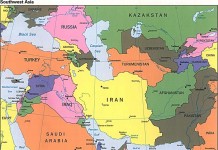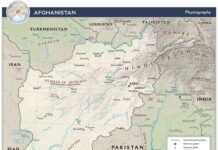
Context
Syria has emerged as one of the most critical fault line for the global balance of power struggles. It is perhaps the only place in the world where both the global and regional powers have boots on the ground – such as US, Russia, and Turkey. US has about 900 soldiers based there, while Russian presence constitutes about 5,000 troops, and Turkey according to some estimates has more than 10,000 soldiers in northern Syria carrying out military operations.
Syria is also home to Iranian backed proxies which includes Shiite Hezbollah, and Sunni extremist groups such as ISIL and Al Qaeda. Moreover, there are other local non-state actors that are fighting against the Assad regime, such as the Syrian Democratic Forces (SDF) and Free Syria Army (FSA), with western support and backing of Turkey and other Arab nations, such as UAE, Qatar, and Saudi Arabia. And then there is legacy business of Kurds, Syrian Kurds (YPG) operate from northern Syria against Turkey while also receiving US support for the fight against ISIL.
Arab Spring and Syria
The Arab Spring protests in Syria began in March 2011 as part of a series of pro-democracy demonstrations that swept across the Middle East. The protests initially called for increased civil liberties, greater freedom of speech, and the end of the Ba’ath Party’s rule. The Syrian government responded with a brutal crackdown on protesters, resulting in hundreds of deaths and thousands of arrests. As the protests continued, the government’s reaction grew increasingly violent, and the conflict escalated into a full-scale civil war and millions of refugees. Close to 3.5 million Syrian refugees migrated to Turkey while others went to different places in MENA region, Europe, and the US.
The threat posed by the Islamic State of Iraq and the Levant (ISIL) emerged in Syria around 2011. The group joined forces with other extremist groups in the region to fight against the Assad government – and quickly gained control over large swathes of territory in the country. ISIL was eventually defeated in Syria in March 2019.
The Assad regime in Syria was able to survive largely due to support from Russia, Iran, Hezbollah. They provided the Assad regime with military and financial support, enabling it to remain in power despite the civil war and international sanctions. Iran sent thousands of militiamen to fight alongside Syrian government forces in their fight against ISIL, SDF, and FSA that were operating to topple the Syrian government. Additionally, the Assad regime was able to rely on its strong security apparatus to repress domestic opposition and maintain control over the country. At the same time, while US, Turkey, and UAE were backing groups such as SDF and FSA to remove Assad, they were also fighting against ISIL.
As the extremist threat diminished, which was a common threat for state actors operating in Syria, the fissures became apparent along the respective geopolitical interests that are tied to the great power competition.
The Fight to Remove Assad’s Regime and Iran
Since the beginning of Arab Spring, one of the overarching aspirations has been to do deal with the wider Iranian behavior and influence in the Middle East, and constraining its nuclear and missile program. From the perspective of Israel and the US, any potential regime change in Syria would have undermined Iran and its control over Hezbollah – that extends its influence into Lebanon and Palestinian territories. Moreover, Iranian proxies also complicate the Middle East Peace Process between Israel and Palestine.
To counter this, Israel has simultaneously been working on what has come to be known as the Outside-In Approach to the Israeli-Palestinian conflict, and associated with it the ‘War between Wars’ strategy. The premise of the Outside-In approach has been to alter the regional dynamics to such an extent that it leads to diminished Arab support for the Palestinian cause – this would make the Palestinian more amenable to accept peace on Israeli terms. The approach also envisions undermining Iran’s nuclear and missile program while maintaining the threat of military action against Iran. This overtime led to the agreements which came to be known as Abraham Accords in 2020 and normalization of ties between UAE, Bahrain, Sudan, Morocco and Israel.
One the other hand, the main focus of the ‘War between Wars’ strategy is to prevent Iran from getting entrenched in Syria and thus threatened Israel directly via Lebanon. According to some estimates close to 2500 Iranian Revolutionary Guard members are operating in Syria.
Russian Role in Syria
The Russian support of Assad’s government and military intervention in 2015, directly undercuts the objective of regime change. Moreover, Israeli strikes against Iranian targets and Hezbollah in Syria risks hurting ties with Russia. Yet Israel has maintained close ties with Russia despite their differences over the Syrian conflict. Israel and Russia cooperate on a variety of matters, including security and trade. Additionally, the two countries have developed a mechanism to de-conflict their operations in Syria and ensure that their forces do not come into conflict with one another. Despite their differences, Israel and Russia have managed to maintain a good working relationship.
On the other hand, Russia has provided the Assad regime with military, financial, and political support, helping to keep it in power despite international sanctions and widespread opposition. Additionally, Russia has deployed thousands of troops and airpower to support the government in its fight against the FSA, SDF, and ISIL. To keep amicable ties with Turkey, Russia has generally maintained a neutral stance towards the Kurdish-led YPG in Syria.
In addition to air bases, Russia also maintains a naval base in Tartous. The larger Russian strategy is not only to protect the Assad regime but also maintain a foothold in the larger Middle East and North Africa. Russia is also military involved directly or through mercenaries in Libya and Sudan. But the conflict in Ukraine has had a significant impact on Russia’s military presence in Syria. Following the outbreak of the war in Ukraine in 2014, the United States and its allies imposed economic sanctions on Russia hitting its economy. As a result, Russia has had to reduce its military presence in Syria and focus its resources on the conflict in Ukraine.
Turkey, YPG, PKK and Syria

Turkey is another stakeholder to the conflict in Syria, it has carried out military operations against the Kurdish-led YPG. Additionally, Turkey has sought to maintain a buffer zone along its border with Syria, which has been opposed by the YPG. Turkey’s actions against the YPG have caused tensions with the United States since it supports the group in its fight against ISIL – and YPG has collaboration with SDF and FSA to topple Assad’s regime. Being a NATO member, Turkey has also provided the SDF and FSA with arms, training, and financial support in their fight against the Assad regime.
On the other hand, both Russia and Iran have not directly engaged in the conflict between YPG and the Assad government and accused the group of cooperating with the United States and other foreign powers.
The Kurdistan Workers’ Party (PKK) and the Kurdish-led YPG in Syria have a close ideological and organizational relationship. The PKK has provided the YPG with military and financial support in its fight against ISIL, as well as political and diplomatic support in international forums. Additionally, many members of the PKK have joined the YPG in its fight against ISIL.
Like Turkey, US and EU consider PKK a terrorist organization. This approach which supports YPG in Syria but considers PKK a terrorist group, complicates US and European ties with Turkey and NATO – and raises Turkish concerns about the real intent behind supporting separatist YPG.
Saudi-Iran Detente
The question becomes how the situation of Syria will impact the Chinese facilitated Saudi-Iran truce reached in March. Or, in other words, what are the key terms of the détente reached by Saudi Arabia and Iran, that will facilitate establishing a regional balance of power and resolve proxy wars in places like Yemen, Iraq, Syria, Lebanon, Libya, and Palestine. Moreover, what does it imply for the budding great power rivalry in South Asia.
One of the immediate benefits of the truce has been the ceasefire in Yemen, followed up by exchange of prisoners. The foreign minister of Syria has also visited Saudi Arabia, reciprocated by the Saudi Foreign Minister’s trip to Syria – raising hopes for potential reentry of Syria into the Arab League. Earlier in March, Assad had also visited UAE to rebuild ties that had been cut-off due to the support provided by Gulf States to anti-Assad Forces.
Iran’s nuclear program and the threat posed by its wider behavior in the region, represented the threat perception that had moved the Arab world closer to Israel – and by extension to the US. Additionally, the criticism of the Abraham Accord, reached in 2020, has been that it has not resulted in any quid-pro-quo when it comes to Israeli-Palestinian conflict. In fact, with the return of Netanyahu’s right-wing government and the aggressive actions it has taken, has reversed the gains made under the Abraham agreement. This has adversely impacted Israeli ties with the US.
However, it is also a fact that US interests in the Middle East have transformed in the aftermath of the campaign against extremism, and military withdrawal from Iraq and Afghanistan. It is no longer dependent on the energy resources of the region, as China is, but it is engaged head on in the great power rivalry with China and Russia. The Middle Powers are caught in the middle of these power tussles. According to the White House Coordinator for MENA, Brett McGurk, the main objectives of US in Syria are to reduce the violence, maintain a check on the activities of ISIL, help the Syrian humanitarian crisis, and back Israel.
The shift in UAE and Saudi position reflects a realization the Assad’s regime has survived the worse with Russian and Iranian support. The China, Iran Economic and Security Deal reached in 2020 demonstrated that China was also throwing its weight behind Iran, which has traditionally been also backed by Russia. PoliTact had pointed out at that time that the pact represented China’s pivot to the Middle East. With the China facilitating the Saudi-Iran truce, the balance of power appear to be shifting away from the US, which is increasingly been seen as an unreliable partner. Commenting on the deal, former Israeli prime minister commented that “This is a fatal blow to the effort to build a regional coalition against Iran.”
Will Israel counter or accept any potential guarantees from China that it can manage Iranian nuclear program and wider behavior in the region, remains to be seen. The new Chinese foreign minister Qin Gang recently stated that it is ready to mediate peace talks between Israel and Palestine.
Meanwhile, the Secretary of State Mike Pompeo had warned Israel in 2019 to reduce its economic and security ties with China or risk reduced security cooperation from US. During his visit to Saudi Arabia in 2022, President Biden had stated, “We will not walk away and leave a vacuum to be filled by China, Russia or Iran … We will seek to build on this moment with active, principled, American leadership.”
Related:
- What Does President Biden’s Visit To Israel And Saudi Arabia Imply? Aug 4, 2022
- Biden’s Middle East Policy, China-Iran Ties, and CPEC
On July 28, 2020, PoliTact held a webinar to discuss the potential China-Iran economic deal and its impact on the China-Pakistan Economic Corridor (CPEC)
- PoliTact’s Chief Analyst Arif Ansar’s interview on the situation of Syria on Pakistan Television, March 2023



